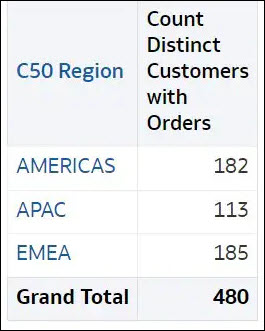レポート合計の集計ルールの割当て
このトピックは、レポート合計の集計ルールを明示的に割り当てる方法について説明しています。これは、パフォーマンスの向上に役立ち、特にOracle Analyticsでレポートを記述する技術開発者を対象としています。
次の図は、レポート定義が年、月および顧客地域で、メトリックが重複を除いた顧客数(オーダーあり)として定義される(Count Distinct of Customers with Orders)例を示しています。

図ceal_report_totals_example.jpgの説明
論理問合せは次のようになります。
SELECT
0 s_0,
"A - Sample Sales"."Cust Regions"."C50 Region" s_1,
"A - Sample Sales"."Counts"."32 # of Cust with Orders (Cnt Distinct)" s_2,
REPORT_AGGREGATE("A - Sample Sales"."Counts"."32 # of Cust with Orders (Cnt Distinct)" BY ) s_3
FROM "A - Sample Sales"
WHERE
("Time"."T02 Per Name Month" = '2011 / 11')
ORDER BY 2 ASC NULLS LAST
FETCH FIRST 500001 ROWS ONLY物理問合せは次のようになります。
WITH
SAWITH0 AS (select count(distinct T42433.Cust_Key) as c1,
T42430.Region as c2
from
BISAMPLE.SAMP_CUSTOMERS_D T42428 /* D60 Customers */ ,
BISAMPLE.SAMP_ADDRESSES_D T42430 /* D62 Customers Addresses */ ,
BISAMPLE.SAMP_TIME_MTH_D T42405 /* D02 Time Month Grain */ ,
BISAMPLE.SAMP_REVENUE_F T42433 /* F10 Billed Rev */
where ( T42405.Mth_Key = T42433.Bill_Mth_Key and T42405.Per_Name_Month = '2011 / 11' and T42428.Cust_Key = T42433.Cust_Key and T42428.Address_Key = T42430.Address_Key )
group by T42430.Region),
SAWITH1 AS (select count(distinct T42433.Cust_Key) as c1
from
BISAMPLE.SAMP_TIME_MTH_D T42405 /* D02 Time Month Grain */ ,
BISAMPLE.SAMP_REVENUE_F T42433 /* F10 Billed Rev */
where ( T42405.Per_Name_Month = '2011 / 11' and T42405.Mth_Key = T42433.Bill_Mth_Key ) )
select D1.c1 as c1, D1.c2 as c2, D1.c3 as c3, D1.c4 as c4 from ( select D1.c1 as c1,
D1.c2 as c2,
D1.c3 as c3,
D1.c4 as c4
from
(select 0 as c1,
D1.c2 as c2,
D1.c1 as c3,
D2.c1 as c4,
ROW_NUMBER() OVER (PARTITION BY D1.c2 ORDER BY D1.c2 ASC) as c5
from
SAWITH0 D1,
SAWITH1 D2
) D1
where ( D1.c5 = 1 )
order by c2 ) D1 where rownum <= 500001
合計値の480は、構成値の182 + 113 + 185の合計です。合計を計算する論理問合せの式は、“REPORT_AGGREGATE("A - Sample Sales"."Counts"."32 # of Cust with Orders (Cnt Distinct)" BY ) s_3”となります。
REPORT_AGGREGATEが使用される場合、合計は構成値とは関係なく計算されます。ただし、このレポート設計では、このレポートの構成値から正しい合計を計算できます。
列式を編集して「集計ルール(合計行)」を「サーバー複合集計」から「合計」に変更すると、論理SQL問合せおよび物理SQL問合せが変更されます。
次の図は、元の集計を示しています。

図ceal_original_aggregation.pngの説明
次の図は、変更後の集計を示しています。

図ceal_modified_aggregation.pngの説明
変更された論理SQL問合せにはREPORT_SUMがあります:
SELECT
0 s_0,
"A - Sample Sales"."Cust Regions"."C50 Region" s_1,"A - Sample Sales"."Counts"."32 # of Cust with Orders (Cnt Distinct)" s_2,
REPORT_SUM("A - Sample Sales"."Counts"."32 # of Cust with Orders (Cnt Distinct)" BY ) s_3
FROM "A - Sample Sales"
WHERE
("Time"."T02 Per Name Month" = '2011 / 11')
ORDER BY 2 ASC NULLS LAST
FETCH FIRST 500001 ROWS ONLYこれは、生成される物理問合せです。
WITH
SAWITH0 AS (select count(distinct T42433.Cust_Key) as c1,
T42430.Region as c2
from
BISAMPLE.SAMP_CUSTOMERS_D T42428 /* D60 Customers */ ,
BISAMPLE.SAMP_ADDRESSES_D T42430 /* D62 Customers Addresses */ ,
BISAMPLE.SAMP_TIME_MTH_D T42405 /* D02 Time Month Grain */ ,
BISAMPLE.SAMP_REVENUE_F T42433 /* F10 Billed Rev */
where ( T42405.Mth_Key = T42433.Bill_Mth_Key and T42405.Per_Name_Month = '2011 / 11' and T42428.Cust_Key = T42433.Cust_Key and T42428.Address_Key = T42430.Address_Key )
group by T42430.Region),
SAWITH1 AS (select 0 as c1,
D1.c2 as c2,
D1.c1 as c3
from
SAWITH0 D1)
select D1.c1 as c1, D1.c2 as c2, D1.c3 as c3, D1.c4 as c4 from ( select D1.c1 as c1,
D1.c2 as c2,
D1.c3 as c3,
sum(D1.c3) over () as c4
from
SAWITH1 D1
order by c2 ) D1 where rownum <= 500001
明示的に集計を設定する同じオプションをワークブックで使用できますビジュアライゼーションの数値の書式設定を参照してください。この例では、列「Count Distinct Customers with Orders」で、「集計方法」を「合計」に変更します。
レポートをレビューして、最適な集計ルールがレポートで使用されていることを確認します。レポート設計で許可されている場合は、明示的な集計ルールを使用してください。
レポートの詳細は、「分析の作成」を参照してください。